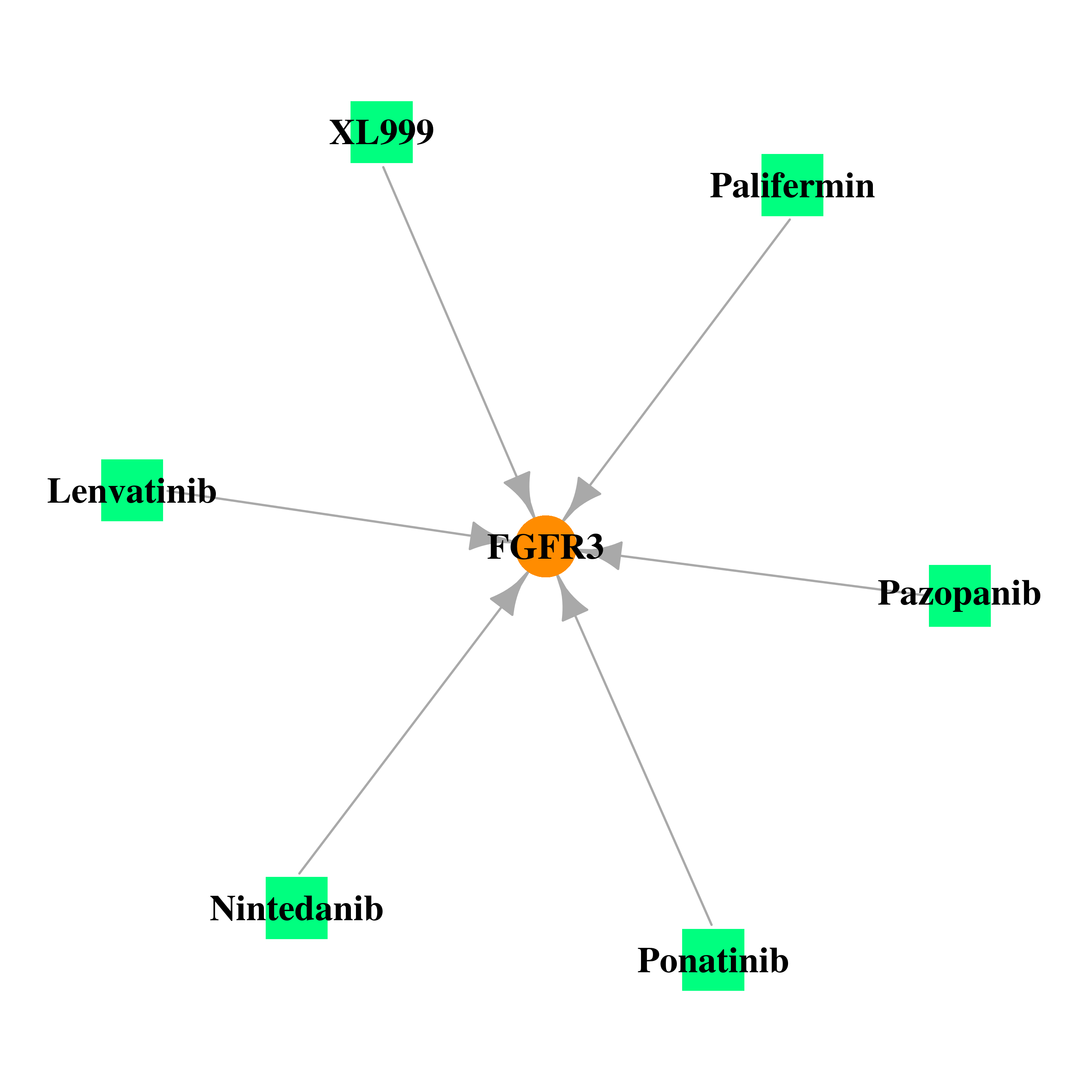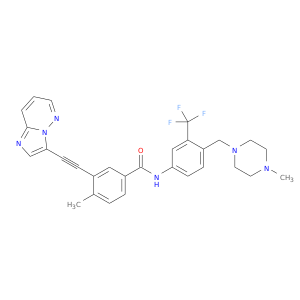| Basic gene Info. | Gene symbol | FGFR3 |
| Gene name | fibroblast growth factor receptor 3 |
| Synonyms | ACH|CD333|CEK2|HSFGFR3EX|JTK4 |
| Cytomap | UCSC genome browser: 4p16.3 |
| Type of gene | protein-coding |
| RefGenes | NM_000142.4,
NM_001163213.1,NM_022965.3, |
| Description | FGFR-3fibroblast growth factor receptor 3 variant 4hydroxyaryl-protein kinasetyrosine kinase JTK4 |
| Modification date | 20141219 |
| dbXrefs | MIM : 134934 |
| HGNC : HGNC |
| Ensembl : ENSG00000068078 |
| HPRD : 00624 |
| Vega : OTTHUMG00000121148 |
| Protein | UniProt: P22607
go to UniProt's Cross Reference DB Table |
| Expression | CleanEX: HS_FGFR3 |
| BioGPS: 2261 |
| Pathway | NCI Pathway Interaction Database: FGFR3 |
| KEGG: FGFR3 |
| REACTOME: FGFR3 |
| Pathway Commons: FGFR3 |
| Context | iHOP: FGFR3 |
| ligand binding site mutation search in PubMed: FGFR3 |
| UCL Cancer Institute: FGFR3 |
| Assigned class in mutLBSgeneDB | A: This gene has a literature evidence and it belongs to targetable_mutLBSgenes. |
| References showing study about ligand binding site mutation for FGFR3. | 1. "Wilkie AO, Oldridge M, Tang Z, Maxson RE Jr. Craniosynostosis and related limb anomalies. Novartis Found Symp. 2001;232:122-33; discussion 133-43. Review. PubMed PMID: 11277076. " 11277076
2. "Lievens PM, Liboi E. The thanatophoric dysplasia type II mutation hampers complete maturation of fibroblast growth factor receptor 3 (FGFR3), which activates signal transducer and activator of transcription 1 (STAT1) from the endoplasmic reticulum. J Biol Chem. 2003 May 9;278(19):17344-9. Epub 2003 Mar 6. PubMed PMID: 12624096. " 12624096
3. "Barroso E, Pérez-Carrizosa V, García-Recuero I, Glucksman MJ, Wilkie AO, García-Minaur S, Heath KE. Mild isolated craniosynostosis due to a novel FGFR3 mutation, p.Ala334Thr. Am J Med Genet A. 2011 Dec;155A(12):3050-3. doi:10.1002/ajmg.a.34199. Epub 2011 Oct 28. PubMed PMID: 22038757. " 22038757
|
| cf) Cancer type abbreviation. BLCA: Bladder urothelial carcinoma, BRCA: Breast invasive carcinoma, CESC: Cervical squamous cell carcinoma and endocervical adenocarcinoma, COAD: Colon adenocarcinoma, GBM: Glioblastoma multiforme, LGG: Brain lower grade glioma, HNSC: Head and neck squamous cell carcinoma, KICH: Kidney chromophobe, KIRC: Kidney renal clear cell carcinoma, KIRP: Kidney renal papillary cell carcinoma, LAML: Acute myeloid leukemia, LUAD: Lung adenocarcinoma, LUSC: Lung squamous cell carcinoma, OV: Ovarian serous cystadenocarcinoma, PAAD: Pancreatic adenocarcinoma, PRAD: Prostate adenocarcinoma, SKCM: Skin cutaneous melanoma, STAD: Stomach adenocarcinoma, THCA: Thyroid carcinoma, UCEC: Uterine corpus endometrial carcinoma. |
| Disease ID | Disease name | # PubMed | Association type |
| umls:C0001080 | Achondroplasia | 110 | Biomarker, GeneticVariation |
| umls:C0026764 | Multiple Myeloma | 68 | AlteredExpression, Biomarker, GeneticVariation |
| umls:C1868678 | Thanatophoric Dysplasia, Type I | 60 | Biomarker, GeneticVariation |
| umls:C0005684 | Malignant neoplasm of bladder | 57 | Biomarker, GeneticVariation |
| umls:C0039743 | Thanatophoric Dysplasia | 54 | Biomarker, GeneticVariation |
| umls:C0410529 | Hypochondroplasia | 53 | Biomarker, GeneticVariation |
| umls:C0005695 | Urinary Bladder Neoplasms | 34 | Biomarker, GeneticVariation |
| umls:C0007138 | Carcinoma, Transitional Cell | 19 | Biomarker, GeneticVariation |
| umls:C1864436 | Muenke Syndrome | 15 | Biomarker, GeneticVariation |
| umls:C0022603 | Keratosis, Seborrheic | 15 | Biomarker, GeneticVariation |
| umls:C1300257 | Thanatophoric dysplasia, type 2 | 10 | Biomarker, GeneticVariation |
| umls:C2677099 | Crouzon Syndrome With Acanthosis Nigricans | 10 | Biomarker, GeneticVariation |
| umls:C0302592 | Cervix carcinoma | 6 | Biomarker, GeneticVariation |
| umls:C0007873 | Uterine Cervical Neoplasms | 2 | Biomarker |
| umls:C0265269 | Lacrimoauriculodentodigital syndrome | 1 | Biomarker, GeneticVariation |
| umls:C0036631 | Seminoma | 1 | Biomarker, GeneticVariation |
| umls:C0008924 | Cleft Lip | 1 | Biomarker |
| umls:C0008925 | Cleft Palate | 1 | Biomarker |
| umls:C0175699 | Saethre-Chotzen Syndrome | 1 | GeneticVariation |
| LBS | AA sequence | # species | Species |
A506 | KPVTVAVKMLK | 1 | Homo sapiens | A506 | NEIAVAVKKLK | 1 | Caenorhabditis elegans | A506 | NNAIVAVKMVK | 1 | Drosophila melanogaster | A506 | KAITVAVKMLK | 1 | Gallus gallus | A558 | VLVEYAAKGNL | 1 | Homo sapiens | A558 | VVVELCKHGNL | 1 | Caenorhabditis elegans | A558 | VIVEYAPHGNL | 1 | Drosophila melanogaster | A558 | VLVEYASKGNL | 1 | Gallus gallus | D635 | VMKIADFGLAR | 2 | Homo sapiens, Gallus gallus | D635 | VLKISDFGLSR | 1 | Caenorhabditis elegans | D635 | VLKIADFGLAR | 1 | Drosophila melanogaster | E556 | LYVLVEYAAKG | 1 | Homo sapiens | E556 | LYVVVELCKHG | 1 | Caenorhabditis elegans | E556 | LYVIVEYAPHG | 1 | Drosophila melanogaster | E556 | LYVLVEYASKG | 1 | Gallus gallus | F483 | LGEGCFGQVVM | 2 | Homo sapiens, Gallus gallus | F483 | LGEGAFGEVWK | 1 | Caenorhabditis elegans | F483 | LGEGAFGRVVM | 1 | Drosophila melanogaster | G484 | GEGCFGQVVMA | 2 | Homo sapiens, Gallus gallus | G484 | GEGAFGEVWKA | 1 | Caenorhabditis elegans | G484 | GEGAFGRVVMA | 1 | Drosophila melanogaster | K508 | VTVAVKMLKDD | 1 | Homo sapiens | K508 | IAVAVKKLKMS | 1 | Caenorhabditis elegans | K508 | AIVAVKMVKEG | 1 | Drosophila melanogaster | K508 | ITVAVKMLKDD | 1 | Gallus gallus | L624 | AARNVLVTEDN | 2 | Homo sapiens, Gallus gallus | L624 | AARNVLVGDGH | 1 | Caenorhabditis elegans | L624 | AARNVLVSDDY | 1 | Drosophila melanogaster | N562 | YAAKGNLREFL | 1 | Homo sapiens | N562 | LCKHGNLRDFL | 1 | Caenorhabditis elegans | N562 | YAPHGNLKDFL | 1 | Drosophila melanogaster | N562 | YASKGNLREYL | 1 | Gallus gallus | N622 | DLAARNVLVTE | 2 | Homo sapiens, Gallus gallus | N622 | DLAARNVLVGD | 1 | Caenorhabditis elegans | N622 | DLAARNVLVSD | 1 | Drosophila melanogaster | R621 | RDLAARNVLVT | 2 | Homo sapiens, Gallus gallus | R621 | RDLAARNVLVG | 1 | Caenorhabditis elegans | R621 | RDLAARNVLVS | 1 | Drosophila melanogaster | R655 | KTTNGRLPVKW | 2 | Homo sapiens, Gallus gallus | R655 | KRGNGRLPIKW | 1 | Caenorhabditis elegans | R655 | KNTNGRLPIKW | 1 | Drosophila melanogaster | V486 | GCFGQVVMAEA | 2 | Homo sapiens, Gallus gallus | V486 | GAFGEVWKATY | 1 | Caenorhabditis elegans | V486 | GAFGRVVMAEV | 1 | Drosophila melanogaster | V555 | PLYVLVEYAAK | 1 | Homo sapiens | V555 | PLYVVVELCKH | 1 | Caenorhabditis elegans | V555 | PLYVIVEYAPH | 1 | Drosophila melanogaster | V555 | PLYVLVEYASK | 1 | Gallus gallus |
 Gene summary
Gene summary  Gene ontology having evidence of Inferred from Direct Assay (IDA) from Entrez
Gene ontology having evidence of Inferred from Direct Assay (IDA) from Entrez  Lollipop-style diagram of mutations at LBS in amino-acid sequence.
Lollipop-style diagram of mutations at LBS in amino-acid sequence. 
 Cancer type specific mutLBS sorted by frequency
Cancer type specific mutLBS sorted by frequency Relative protein structure stability change (ΔΔE) using Mupro 1.1
Relative protein structure stability change (ΔΔE) using Mupro 1.1  : nsSNV at non-LBS
: nsSNV at non-LBS : nsSNV at LBS
: nsSNV at LBS
 nsSNVs sorted by the relative stability change of protein structure by each mutation
nsSNVs sorted by the relative stability change of protein structure by each mutation  Structure image for FGFR3 from PDB
Structure image for FGFR3 from PDB Differential gene expression between mutated and non-mutated LBS samples in all 16 major cancer types
Differential gene expression between mutated and non-mutated LBS samples in all 16 major cancer types Differential co-expressed gene network based on protein-protein interaction data (CePIN)
Differential co-expressed gene network based on protein-protein interaction data (CePIN) Gene level disease information (DisGeNet)
Gene level disease information (DisGeNet)  Mutation level pathogenic information (ClinVar annotation)
Mutation level pathogenic information (ClinVar annotation)  Gene expression profile of anticancer drug treated cell-lines (CCLE)
Gene expression profile of anticancer drug treated cell-lines (CCLE)
 Gene-centered drug-gene interaction network
Gene-centered drug-gene interaction network 
 Drug information targeting mutLBSgene (Approved drugs only)
Drug information targeting mutLBSgene (Approved drugs only)





 Gene-centered ligand-gene interaction network
Gene-centered ligand-gene interaction network 
 Ligands binding to mutated ligand binding site of FGFR3 go to BioLip
Ligands binding to mutated ligand binding site of FGFR3 go to BioLip Multiple alignments for P22607 in multiple species
Multiple alignments for P22607 in multiple species 
